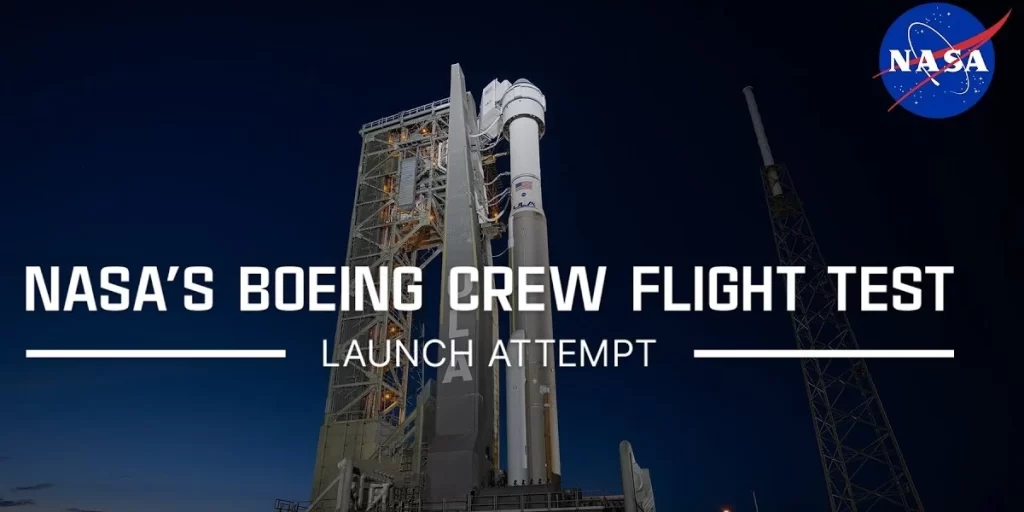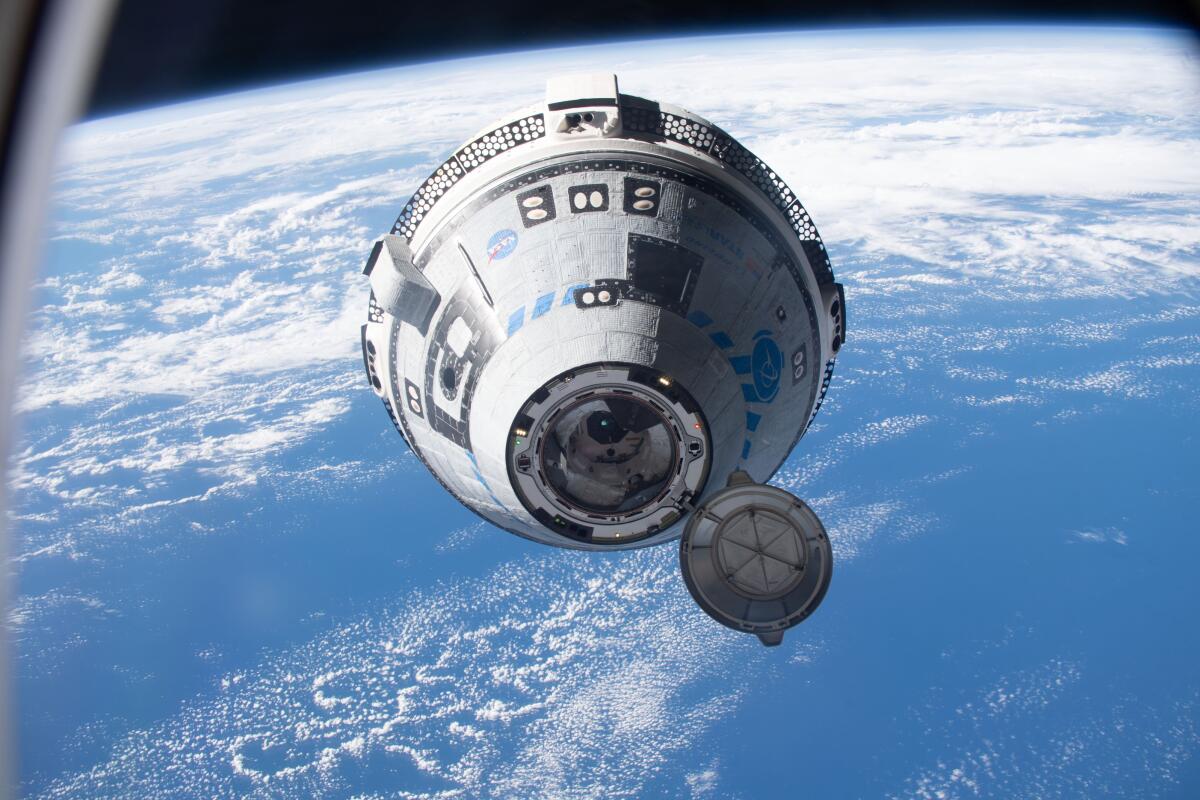Boeing’s Starliner’s first-ever astronaut mission is underway.
Launch from Cape Canaveral Space Force Station
Boeing’s Starliner’s launch from Launch Complex 41 at Cape Canaveral Space Force Station is a monumental event in the history of space exploration. It signifies the beginning of a new era in commercial crew transportation, showcasing the culmination of years of planning, development, and collaboration between Boeing, NASA, and United Launch Alliance (ULA). The successful liftoff of Starliner represents a significant achievement for ULA’s Atlas V rocket, demonstrating its reliability and capability to launch crewed missions to the International Space Station (ISS) and beyond.
h3>What Actually Are Astronaut Missions: Exploring Beyond Earth’s Bounds
Astronaut missions encapsulate humanity’s relentless pursuit of exploration beyond the confines of Earth’s atmosphere. These endeavors epitomize the pinnacle of human achievement, melding cutting-edge technology with the audacious spirit of adventure. Each mission represents a carefully orchestrated symphony of scientific inquiry, engineering prowess, and human determination. From the iconic Apollo lunar landings to the ongoing expeditions aboard the International Space Station (ISS), astronaut missions have pushed the boundaries of our understanding and capabilities.
At their core, astronaut missions serve multifaceted objectives. They facilitate groundbreaking scientific research, ranging from studying the effects of microgravity on the human body to conducting experiments in biology, physics, and materials science that are impossible to replicate on Earth. Moreover, these missions enable vital technological advancements, spurring innovation in fields such as robotics, propulsion systems, and life support technologies.
Beyond their scientific and technological significance, astronaut missions inspire awe and captivate imaginations worldwide. They embody humanity’s innate curiosity and drive to explore the unknown, offering glimpses into the vast expanse of the cosmos and our place within it. Through their bravery and dedication, astronauts become ambassadors of humanity, forging connections that transcend national boundaries and unite us in our shared quest for knowledge and discovery.
Boeing’s Starliner: Charting the Course for Commercial Crew Success Despite Setbacks , What is The Starline
Boeing’s Starliner mission refers to the CST-100 Starliner spacecraft developed by Boeing as part of NASA’s Commercial Crew Program. The goal of the program is to develop spacecraft capable of transporting astronauts to and from the International Space Station (ISS).
Boeing’s Starliner has undergone various testing phases, including uncrewed orbital flight tests and pad abort tests, with the aim of achieving crewed missions to the ISS. The development and testing process has faced challenges and delays, including issues encountered during the uncrewed Orbital Flight Test (OFT) in December 2019.
The OFT experienced anomalies, preventing the spacecraft from docking with the ISS as planned. Boeing and NASA have been working to address the issues identified during this test before proceeding with crewed missions.
The Starliner mission represents Boeing’s effort to provide crewed space transportation services and is part of NASA’s broader strategy to rely on commercial partners for crew transportation to low Earth orbit destinations like the ISS.
Aboard the Starliner: Veteran Astronauts
The presence of seasoned astronauts Barry “Butch” Wilmore and Suni Williams aboard the Starliner adds a layer of experience and expertise to the mission. With their extensive flight hours and background as Navy test pilots, Wilmore and Williams bring a wealth of knowledge and skill to the operation of the spacecraft. Their leadership during the mission and involvement in testing and certification activities contribute to ensuring the safety and success of the mission objectives.
Mission Objectives: Testing and Certification
The primary objective of the Starliner mission is to conduct thorough testing and evaluation of the spacecraft’s performance and systems in a real-life space environment. During their time aboard the ISS, Wilmore and Williams will execute a series of maneuvers, tests, and simulations to validate the spacecraft’s capabilities for future operational crewed missions. These activities include manual flying exercises, emergency scenario simulations, and debriefing sessions to gather feedback and insights for continuous improvement.
Historical Context: Achieving NASA’s Goals
The launch of Starliner represents a significant milestone in NASA’s quest to foster commercial partnerships for space exploration. Since the inception of the commercial crew program in 2006, NASA has been working towards the goal of enabling commercial entities to provide crew transportation services to the ISS. The successful launch of Starliner brings NASA closer to achieving this objective, marking a pivotal moment in the agency’s history of space exploration.
Challenges and Delays: Road to Launch
The journey to launch has been riddled with challenges and delays, underscoring the complexities involved in developing and certifying crewed spacecraft. From technical issues to scheduling conflicts, the path to liftoff has been far from straightforward. However, the perseverance and dedication of the teams involved, including Boeing, NASA, and ULA, have ultimately led to the successful launch of Starliner, demonstrating resilience in the face of adversity.
Technical Hurdles: Overcoming Setbacks
Despite encountering technical hurdles along the way, such as valve malfunctions and helium leaks, the mission team’s meticulous analysis and problem-solving efforts have allowed them to address these issues effectively. Through rigorous testing and thorough evaluations, the team has ensured the safety and reliability of the spacecraft for crewed missions. The successful resolution of these challenges highlights the ingenuity and expertise of the engineers and technicians involved in the project.
Certification Process: Toward Operational Flights
The Crew Flight Test (CFT) serves as a crucial step in the certification process for Starliner, laying the foundation for future operational crewed missions. By subjecting the spacecraft to real-world conditions and scenarios, the mission aims to validate its performance and readiness for extended missions to the ISS and other destinations. The insights gained from CFT will inform improvements and optimizations to enhance the spacecraft’s capabilities for future crewed flights.
Future Prospects: Operational Missions
Looking ahead, the successful completion of CFT will pave the way for Starliner to fulfill its role as a reliable transportation system for NASA’s crewed missions. With plans for operational flights to the ISS and potentially other destinations beyond low Earth orbit, Starliner holds immense promise for the future of human space exploration. The lessons learned from CFT will guide the development and execution of future missions, shaping the trajectory of commercial spaceflight in the years to come.
Evolution of Commercial Spaceflight: From Cargo to Crew
The commercial crew program builds upon the foundation established by the commercial cargo program, which paved the way for private companies to resupply the ISS with supplies and equipment. By leveraging similar models and approaches, NASA has fostered a thriving ecosystem of commercial partners capable of providing both cargo and crew transportation services to the ISS. This evolution reflects NASA’s commitment to innovation and collaboration in advancing human space exploration.
Investment and Development: Support for Commercial Partners
NASA’s investment in commercial partners, including Boeing and SpaceX, has been instrumental in accelerating the development and deployment of crewed spacecraft. Through various funding initiatives and contracts, NASA has provided critical resources and support to enable the progress of commercial crew transportation capabilities. This strategic partnership approach has proven effective in leveraging private sector expertise and resources to achieve NASA’s exploration goals.
Milestones and Contracts: Funding and Progress
The milestone-based approach employed by NASA, coupled with competitive contracts and incentives, has incentivized innovation and progress among commercial partners. By awarding contracts for specific development milestones and operational objectives, NASA has fostered healthy competition and accountability within the industry. This approach has resulted in significant advancements in crewed spacecraft technology and capabilities, paving the way for the commercialization of space exploration.
Technical Challenges and Solutions: SpaceX vs. Boeing
Both SpaceX and Boeing have faced unique technical challenges and setbacks in the development of their crewed spacecraft. While SpaceX’s Crew Dragon encountered issues with its launch-abort system and parachute deployment, Boeing’s Starliner experienced timing system malfunctions and parachute deployment anomalies. However, the rigorous testing and iterative design processes employed by both companies have enabled them to address these challenges and implement robust solutions. Through collaboration with NASA and other stakeholders, SpaceX and Boeing have demonstrated their ability to overcome obstacles and deliver safe and reliable crewed transportation systems.
Is There Any Need For This Struggle? Unlocking the Potential of Space Exploration: The Significance of Transporting Astronauts to and from the International Space Station (ISS)
Exploring the Gateway to the Cosmos
Transporting astronauts to and from the International Space Station (ISS) is not merely a routine task but a pivotal element in humanity’s quest to unlock the mysteries of the cosmos. The ISS stands as a symbol of international collaboration and scientific advancement, orbiting approximately 400 kilometers above Earth’s surface. Serving as a microgravity laboratory and a platform for groundbreaking research, the ISS has revolutionized our understanding of space and its potential applications.
Advancing Scientific Discovery
One of the primary purposes of ferrying astronauts to and from the ISS is to facilitate scientific research in a microgravity environment. This unique setting allows scientists to conduct experiments that are simply not possible on Earth. From studying the effects of microgravity on biological organisms to testing new materials for space exploration, the ISS serves as a frontier for innovation across various scientific disciplines. Every journey to the ISS brings new opportunities to expand our knowledge of the universe and develop technologies that benefit both space exploration and life on Earth.
Fostering International Collaboration
The ISS represents a remarkable feat of international cooperation, bringing together space agencies from around the world in a shared pursuit of scientific discovery. Through collaborative efforts, astronauts from different nations work side by side on the ISS, transcending geopolitical boundaries to advance humanity’s collective understanding of space. Transporting astronauts to and from the ISS not only strengthens diplomatic ties but also fosters a sense of unity and mutual respect among nations, showcasing the power of collaboration in achieving common goals.
Pioneering Space Exploration
Beyond its role as a research laboratory, the ISS serves as a crucial stepping stone for future space exploration endeavors. By mastering the logistics of crew transportation and sustaining human presence in space, we pave the way for ambitious missions to distant destinations, such as the Moon, Mars, and beyond. Each journey to the ISS brings us closer to realizing our dreams of venturing deeper into the cosmos, expanding the horizons of human exploration and pushing the boundaries of what is possible.
Inspiring the Next Generation
The missions to transport astronauts to and from the ISS capture the imagination of people around the world, inspiring the next generation of scientists, engineers, and explorers. Through live broadcasts, educational outreach programs, and multimedia coverage, these missions ignite a sense of wonder and curiosity about space exploration. By witnessing humanity’s endeavors in space, young minds are inspired to pursue careers in STEM fields and contribute to the future of space exploration, ensuring that the legacy of the ISS continues to inspire generations to come.
In conclusion, transporting astronauts to and from the International Space Station (ISS) is not merely a logistical operation but a gateway to a future of limitless possibilities. From advancing scientific discovery to fostering international collaboration, pioneering space exploration, and inspiring the next generation, the significance of these missions extends far beyond the confines of Earth’s atmosphere. As we continue to journey to the ISS and beyond, we embark on a collective quest to unravel the mysteries of the cosmos and chart a course towards a brighter future for humanity.
Significance of Success: Implications for Space Exploration
The success of commercial crew transportation initiatives holds significant implications for the future of space exploration. By expanding access to space and reducing reliance on government-operated vehicles, commercial partners like Boeing and SpaceXare democratizing spaceflight and opening up new opportunities for scientific research, technology development, and human settlement beyond Earth. The commercialization of space transportation represents a paradigm shift in the way humanity accesses and utilizes space, unlocking the potential for a vibrant and sustainable space economy.
Future Endeavors: Beyond the Current Mission
Looking beyond the current mission, Boeing and NASA are already planning for future endeavors and opportunities in human spaceflight. With continued investment in spacecraft development, infrastructure, and mission planning, it aims to expand its role in providing crewed transportation services to various destinations in space. Whether supporting ISS operations, conducting scientific research, or enabling commercial space tourism, Starliner holds the potential to shape the future of human space exploration for generations to come.
Limitless Exploration: Embarking on a Journey Beyond
As Starliner embarks on its journey to the ISS and beyond, it embodies the essence of exploration, innovation, and collaboration that defines humanity’s quest for knowledge and discovery. Through the dedication and ingenuity of the teams involved, including Boeing, NASA, and ULA, the mission represents a testament to human achievement and the limitless possibilities of space exploration. With each successful milestone, the boundaries of exploration are pushed further, inspiring future generations to reach for the stars and explore the unknown frontier of space.


)



